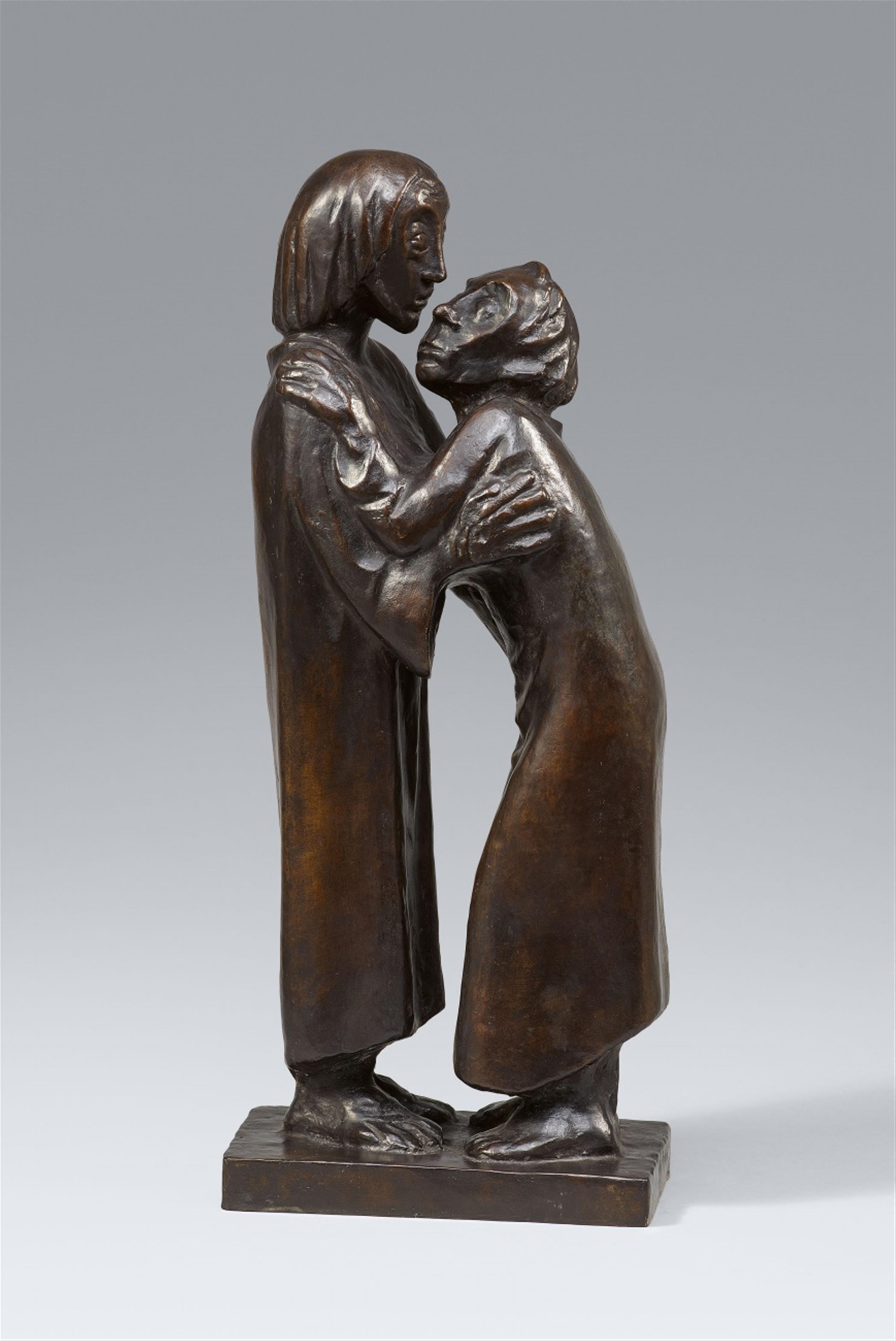Ernst Barlach
Das Wiedersehen (Thomas und Christus)
1926
Bronze Height 48.1 cm Signed 'Barlach' and with foundry mark "H. NOACK BERLIN" on side of plinth. One of 25 unnumbered casts executed since 1938 from a total edition 36 unnumbered exemplars. - Dark brown patina.
The five bronze sculptures by Ernst Barlach which we are able to offer this auction season provide a sense of the artistic development that can be identified in his sculptural oeuvre. The "Russische Bettlerin mit Schale", created in 1906, and the "Russische Bettlerin II" - whose design follows the small version from 1907, although it was first realised at this size in 1932 - illustrate the thematic and artistic impulses that Barlach gleaned from the several weeks he spent travelling in Russia in 1906. After his earliest work, which was influenced by Jugendstil, the artist now found his way to simplified, cohesive forms. He slightly stylised the long robes covering the bodies of Russia's rural populace and transformed them into flowing, ornamental lines. While the representational details and narrative aspect still dominate in the "Bettlerin mit Schale", which was created earlier, he has already transposed the stooped-over figure of the second "Bettlerin" into a thoroughly abstracted form which only vaguely suggests the human body beneath the lengths of fabric.
Drapery also remains a defining element in Barlach's later sculptures, where he constructs the figure through the form of the drapery. It establishes a unifying covering for the body and, through this reduction of form, it ensures a focus on gesture and pose; emotional agitation can also be visualised through it.
From 1910 Barlach's main body of work was strongly influenced by the Gothic sculptures in the churches of his native Northern Germany. He translates the formal principles he saw there into his own expressive idiom. In doing so, he made use of specific compositions from medieval works of sacred art, but without necessarily adopting their iconographic content. He created sculptures which possess a timeless expressive power and visualise fundamental statements of human existence.
The elongated, statuesque figures of Christ and Thomas in "Wiedersehen", from 1926, are interlocked in their physically distant but nonetheless heartfelt embrace; the strongly differentiated poses of their bodies provide an eloquent statement about the circumstances of their encounter. The "Zweifler" of 1930 presents himself in a block-like form with an earthy gravity: the drapery condenses his kneeling body into a unified entity, and his inner strife reveals itself in the angle of the head and the wringing of the hands. The figure of the "Buchleser" from 1936 - also entitled "Lesender Mann im Wind" - likewise presents a self-contained, unified entity; pose and gaze are entirely oriented towards his reading. The slightly billowed drapery of his lap and the dishevelled hair can be interpreted as the effects of the wind, but also as subtle signs of inner agitation.
Catalogue Raisonné
Laur 391; Schult I, 306
Certificate
With an expert report by Hans Barlach, Ratzeburg, dated 3 November 1992 (copy)
Literature
I.a. Friedrich Droß (ed.), Ernst Barlach, Die Briefe II, 1925 - 1938, Munich 1969, no. 1448; Carl Dietrich Carls, Ernst Barlach, Das plastische, graphische und dichterische Werk, Berlin 1931, p. 84 with full-page illus., p. 85; Kunsthalle Mannheim, Bestandskatalog Skulptur, Plastik, Objekt, Mannheim 1982, p. 71, no. 440 with illus.; Kunsthalle Kiel, Katalog der Bildwerke, ed. by Ulrich Bischoff, Rendsburg 1986, p. 29 with full-page illus.; Heinz Spielmann (ed.), Stiftung und Sammlung Rolf Horn, Schleswig 1995, p. 190-191, no. 117 with colour illus.; Heike Stockhaus, Ernst Barlach und der Geist seiner Zeit, in: cat. Rostock 1998, p. 169 with full-page colour illus.; Elisabeth Laur, Vom Jugendstilkünstler zum expressionistischen Holzbildhauer, in: cat. Flensburg/Ribe 2002, p. 50 f.; Naomi Jackson Groves, Ernst Barlach, Leben im Werk. Plastiken, Zeichnungen und Graphiken, Dramen, Prosawerk und Briefe, Taunus 2013, p. 99
Exhibitions
I.a. Berlin 1930 (Galerie Flechtheim), Bronzen von Ernst Barlach, no. 17; Bremen 1959 (Kunsthalle Bremen), Ernst Barlach, no. 501; Berlin 1981 (Akademie der Künste), Ernst Barlach. Werke und Werkentwürfe aus fünf Jahrzehnten, no. 61 with illus. on frontispiece; Kiel 1998 (Kunsthalle Kiel), Ernst Barlach. Mehr als ich, p. 109 with full-page colour illus.; Rostock 1998 (Kunsthalle Rostock), Ernst Barlach. Artist of the North, p. 169 with full-page colour illus.; Flensburg/Ribe 2002 (Museumsberg Flensburg/Ribe Kunstmuseum), Ernst Barlach, Wege und Wanderungen. Vom Jugendstil zum Expressionismus, no. 25; Hamburg 2003 (Hauptkirche St. Katharinen), Ernst Barlach, Mystiker der Moderne, p. 298; Kyoto/Tokyo/Yamanashi 2006 (The National Museum of Modern Art/The Universitiy Art Museum/Tokyo National University of Fine Arts and Music/Yamanashi Prefectural Museum of Art), Ernst Barlach Retrospective, no. 142

